A recently acquired used Swift canoe has been neglected by its previous owner. Clearly left outside without cover and on the ground. The serial # indicates it is 22 years old.
All the wood members seats, yoke, handles need to be replaced. Having replaced these in the past I'm comfortable with that work and have already started on that effort.
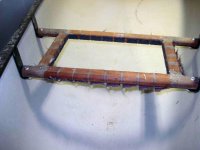
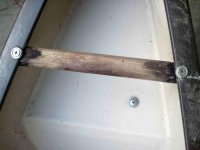
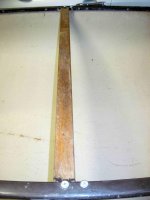
Gunnel Issues
However, when I saw the gunnels I had some indecision on whether or not to purchase the canoe. But the price was very low and the hull itself in fine shape, so I opted to buy it and trust that I would find a way to rehab the gunnels.
The gunnels appear to be vinyl clad aluminum. The vinyl is very thin - perhaps the thickness of card stock. It appears the canoe side that laid on the ground collected water in the underwale (is that a word?) and gradually the water forced its way under the edge of the vinyl and the process of the vinyl separating from the aluminum gunnel has started.
Clearly replacing the gunnels is an option, but not one that I would like to take on. I've not done it before and with shipping costs it is quite pricey to obtain them.
In trying to keep down the costs associated with bringing this canoe back into service I'd like to leave the existing gunnel in place and see if I can't patch it some way.
One suggestion I've received (thanks Mike) is to take a paint scraper and scrape away the loose and flaking vinyl. Then clean the surfaces and apply a thin layer of epoxy over the exposed metal to create a physical barrier in inhibit water penetration at the vinyl/metal transition points. Then paint the gunnel using an appropriate paint.
Welcoming other ideas at this point that don't involve replacing the gunnels. I'm looking for inexpensive solutions that could work - Plan B could be replacing the gunnels but only as a last resort.
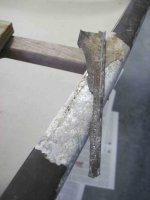
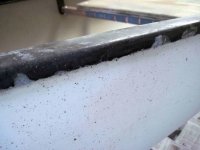
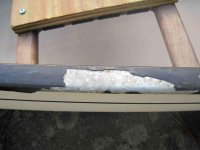
All the wood members seats, yoke, handles need to be replaced. Having replaced these in the past I'm comfortable with that work and have already started on that effort.



Gunnel Issues
However, when I saw the gunnels I had some indecision on whether or not to purchase the canoe. But the price was very low and the hull itself in fine shape, so I opted to buy it and trust that I would find a way to rehab the gunnels.
The gunnels appear to be vinyl clad aluminum. The vinyl is very thin - perhaps the thickness of card stock. It appears the canoe side that laid on the ground collected water in the underwale (is that a word?) and gradually the water forced its way under the edge of the vinyl and the process of the vinyl separating from the aluminum gunnel has started.
Clearly replacing the gunnels is an option, but not one that I would like to take on. I've not done it before and with shipping costs it is quite pricey to obtain them.
In trying to keep down the costs associated with bringing this canoe back into service I'd like to leave the existing gunnel in place and see if I can't patch it some way.
One suggestion I've received (thanks Mike) is to take a paint scraper and scrape away the loose and flaking vinyl. Then clean the surfaces and apply a thin layer of epoxy over the exposed metal to create a physical barrier in inhibit water penetration at the vinyl/metal transition points. Then paint the gunnel using an appropriate paint.
Welcoming other ideas at this point that don't involve replacing the gunnels. I'm looking for inexpensive solutions that could work - Plan B could be replacing the gunnels but only as a last resort.



